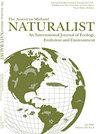Understanding Habitat Use and Activity Patterns of Ornate Box Turtle (Terrapene ornata) in Eastern New Mexico
IF 0.6
4区 环境科学与生态学
Q4 Agricultural and Biological Sciences
引用次数: 1
Abstract
Abstract. The ornate box turtle (Terrapene ornata) is a terrestrial Emydid, listed as near threatened by the International Union for Conservation of Nature Redlist due to habitat destruction, degradation, habitat fragmentation, commercial harvest, and road mortality. Terrapene ornata is secretive, which can pose a challenge to conducting systematic surveys and assessing species status. Studies on the species' biology have relied on opportunistic encounters on the road and the use of radiotelemetry. The objective of this study was to assess the feasibility of using transect line surveys in single season occupancy surveys for T. ornata in Roosevelt County, New Mexico. We further used radiotelemetry to link turtle activity patterns with environmental conditions to aid in understanding detectability of the species. Our occupancy model showed the detection probability to be influenced by individual observers and the time of day. We found T. ornata to most likely occupy habitats with less dense ground cover and avoid highly altered habitats (i.e., cultivated fields). Radiotelemetry further revealed the effect humidity, time of day, and temperature on turtle activity patterns. The lowest activity occurred between 1200–1700 h, whereas peak activity occurred in early morning hours (0600–0900 h). The peak activity occurred between ∼10–25 C and was promoted by higher humidity. Our study represents the first attempt at using transect line surveys for occupancy modeling framework for the ornate box turtles. We suggest that future studies on box turtle occupancy focus on finer scale habitat assessment that would also include vegetation, invertebrate, and small mammal surveys.新墨西哥州东部彩箱龟栖息地利用及活动模式的研究
摘要华丽箱龟(Terrapene ornata)是一种陆生龟,由于栖息地的破坏、退化、栖息地破碎、商业捕捞和道路死亡,被国际自然保护联盟列为近危物种。彩龟是一种隐秘的物种,这对进行系统的调查和评估物种状况构成了挑战。对该物种生物学的研究依赖于在路上偶遇和无线电遥测技术的使用。本研究的目的是评估样线调查在新墨西哥州罗斯福县红腹大蠊单季节占用调查中的可行性。我们进一步使用无线电遥测技术将海龟的活动模式与环境条件联系起来,以帮助了解该物种的可探测性。我们的占用模型显示,检测概率受到个体观测者和一天中的时间的影响。我们发现斑胸草蛾最可能栖息在地表覆盖度较低的栖息地,并避免高度变化的栖息地(即耕地)。无线电遥测进一步揭示了湿度、时间和温度对海龟活动模式的影响。最低活动发生在1200-1700小时之间,而高峰活动发生在清晨(0600-0900小时)。高峰活动发生在~ 10-25℃之间,并受到较高湿度的促进。我们的研究是第一次尝试使用样条线调查来建立华丽箱龟的占用模型框架。我们建议未来对箱龟占用率的研究将重点放在更精细的栖息地评估上,包括植被、无脊椎动物和小型哺乳动物的调查。
本文章由计算机程序翻译,如有差异,请以英文原文为准。
求助全文
约1分钟内获得全文
求助全文
来源期刊

American Midland Naturalist
环境科学-生态学
CiteScore
1.20
自引率
0.00%
发文量
38
审稿时长
18-36 weeks
期刊介绍:
The American Midland Naturalist has been published for 90 years by the University of Notre Dame. The connotations of Midland and Naturalist have broadened and its geographic coverage now includes North America with occasional articles from other continents. The old image of naturalist has changed and the journal publishes what Charles Elton aptly termed "scientific natural history" including field and experimental biology. Its significance and breadth of coverage are evident in that the American Midland Naturalist is among the most frequently cited journals in publications on ecology, mammalogy, herpetology, ornithology, ichthyology, parasitology, aquatic and invertebrate biology and other biological disciplines.
 求助内容:
求助内容: 应助结果提醒方式:
应助结果提醒方式:


